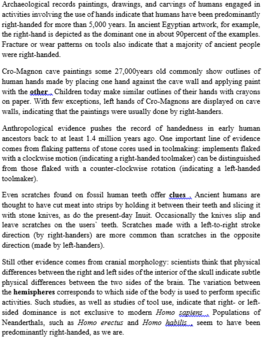Read the following passage and mark the letter A, B, C or D on your answer sheet to indicate the correct answer to each of the questions from 36 to 42.
Forces other than damaging winds are also at work inside tornadoes. Sometimes, as the writhing, twisting funnel passes over a house, the walls and ceiling burst apart as if a bomb had gone off inside. This explosion is caused by the low air pressure at the center of a tornado.
The pressure at the center of a tornado is usually 13 pounds per square inch. However, inside the house, the air pressure is normal, about 15 pounds per square inch. The difference of 2 pounds per square inch between the inside and outside pressure may not seem like much. But suppose a tornado funnel passes over a small building that measures 20 by 10 by 10 feet. On each square inch of the building, there is 2 pounds of pressure from the inside that is not balanced by air pressure outside the building. On the ceiling, that adds up to an unbalanced pressure of 57, 600 pounds. The pressure on the four walls adds up to 172,800 pounds.
If windows are open in the building, some of the inside air will rush out through them. This will balance the pressure inside and outside the building. But if the windows are shut tightly, the enormous inside pressure may cause the building to burst.
Unfortunately, heavy rain and hail often occur in thunderstorms that later produce tornadoes. So people frequently shut all windows to protect their property. This may cause far worse damage later. For the same reason, tornado cellars must have an air vent. Otherwise, the cellar door might be blown out when a tornado passes over it.
According to the passage, tornadoes can destroy buildings because the ________.
A. force of a tornado increases the air pressure in a building
B. air pressure at the center of a tornado is over 172,000 pounds
C. weight of a tornado can crush a building's roof when it passes overhead
D. air pressure inside a tornado is less than the air pressure inside a building








Đáp án D
Thông tin trong bài “This explosion is caused by the low air pressure at the center of a tornado” à áp suất không khí ở bên trong một cơn lốc xoáy thấp hơn áp suất không khí ở bên trong tòa nhà.